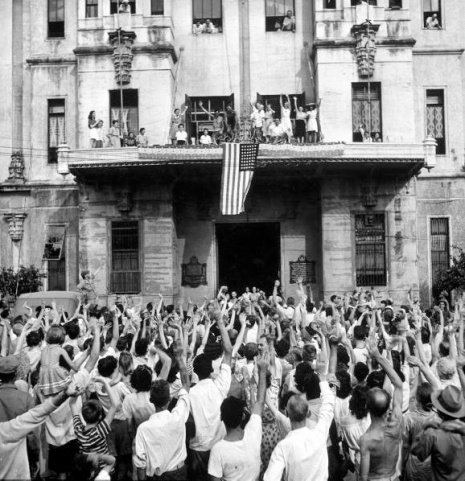



Read this, then look at these.
Just days after Paris was famously liberated from German control in 1944, LIFE photographer Carl Mydans and correspondent John Osborne were eyewitnesses to a grisly affair in the foothills of the French Alps.
On September 2, a group of Resistance fighters gathered near the town of Grenoble to execute a half-dozen Nazi collaborators who had worked for the Milice -- the despised Vichy police. The photos and commentary that ran were simultaneously poignant and terrifying.
Here is a small sample of some of Mydan's rare, chilling photographs that document the horrific event. Be sure to check out the amazing full gallery on
On reflecting on history and on his own involvement in WWII as a bombardier, Howard Zinn contended that there is no “good” war. War poisons everyone involved.


A couple of weeks ago I posted four Library of Congress photographs (attributed to Russell Lee) of Tule Lake internment camp .
In follow up, I encourage you to check out the 200+ images of Tule Lake by Carl Mydans on the Google/LIFE archive. Mydans took these for a LIFE Magazine feature in 1944. [More down the page]






I am especially drawn to the photographs in which Mydans’ presence cannot be ignored – a blinding flash,or fixed stare. Are some of Mydans prints are attempts to be poetic? The scenarios for other prints seem invasive. [More, scroll down]










Mydans’ success was his portraits; his reportage of the interactions between internees and authorities appear to be staged. Maybe pictures were staged, or maybe authorities just fidgeted in front of the camera?





– – – – –
For more about Japanese-American Internment during WWII, refer to the Densho archive of video-recorded oral testimony paired with images and documents of the time. It is the most thorough archive I know of.
– – – – –
Found via International Center for Photography, FANS IN A FLASHBULB blog:
http://fansinaflashbulb.wordpress.com/2010/05/29/tule-lake-internment-camp/
Google announced today that it has come to an arrangement with TimeInc to host the LIFE Archive. The archive is one of the largest collections in the world comprised of over 10 million images. This is an incredible new resource for photophiles worldwide. Twenty percent of the images went live today.

Carl Mydans. American flag draped over balcony of building as American and Filipino civilians cheer their release from the Japanese prison camp at Santo Tomas University folllowing Allied liberation of the city. Manila, Luzon, Philippines. February 05, 1945
A very preliminary search using the keyword “Prison” returned twelve pages of 200 images. I was struck by the strength of the handful of images from the Santo Tomas Prison Liberation Series (Manila, Philippines). The Carl Mydans photographs were captured in the days following the camp’s liberation by allied forces. It was one of four camps liberated in the space of a month in January/February 1945.
Rest assured, I will return to this archive in time to source material and discuss more widely the politics of power partially described by the photographic collection. “Mexico Prison“, with over 150 images, certainly looks like interesting material.

Carl Mydans. Freed American and Filipino prisoners outside main entrance of Santo Tomas University which was used as a Japanese prison camp before Allied liberation forces entered the city. Manila, Luzon, Philippines. February 05, 1945
I would like to make clear that this is a hastily put together post and its main function is to draw attention to this fantastic whale-sized new archive – I might go as far to say our archive – I might even go as far to say its bigger than a whale. I do not condone personal whale ownership.
I would also like to clarify that while the LIFE Archive refers to the Santo Tomas Complex as a prison, it was in fact an internment camp – not that naming conventions matter to those who were subject to its walls and discipline. Still, we must always bear in mind the different types of sites of incarceration; what they purported to do; what, in truth, they did; from what context they arose and operated; and how they fit into our general understanding of humans detaining other humans.

Carl Mydans. Emaciated father feeding Army rations to his son after he and his family were freed from a Japanese prison camp following the Allied liberation of the city. Manila, Luzon, Philippines. February 05, 1945
Personally, I encountered a strange coincidence over this matter. Internment camps are low on my list of primary interest. I am not an expert on internment camps. But, only yesterday I received a fantastic email from a Berkeley art history undergraduate who is focusing on the work of Ansel Adams, Toyo Miyatake and Patrick Nagatani at Manzanar War Relocation Center, California. From the internet monolith that is Google to the academic interests of aspiring students, the histories, memories and powerful images of Second World War internment push themselves to the fore of thought.

Carl Mydans. Two emaciated American civilians, Lee Rogers (L) & John C. Todd, sit outside gym which had been used as a Japanese prison camp following their release by Allied forces liberating the city. Manila, Luzon, Philippines, February 05, 1945
It is conventional wisdom that World War II had two sides. Unfortunately, the military definitions of ‘ally’ and ‘enemy’ spilled into civic life with catastrophic consequences. The US internment of Japanese nationals and Japanese Americans has since been proved to be based not on national security but state-sanctioned discrimination. As testimonies and images attest, where stories are concerned, there are more than two sides.
Click here for the LIFE Archive on Google. Here is an obituary for Carl Mydans, the photographer at Santo Tomas. Try here and here for first-hand account of detention and to find audio and visual resources about Santo Tomas Internment Camp.
Comments
Post a Comment